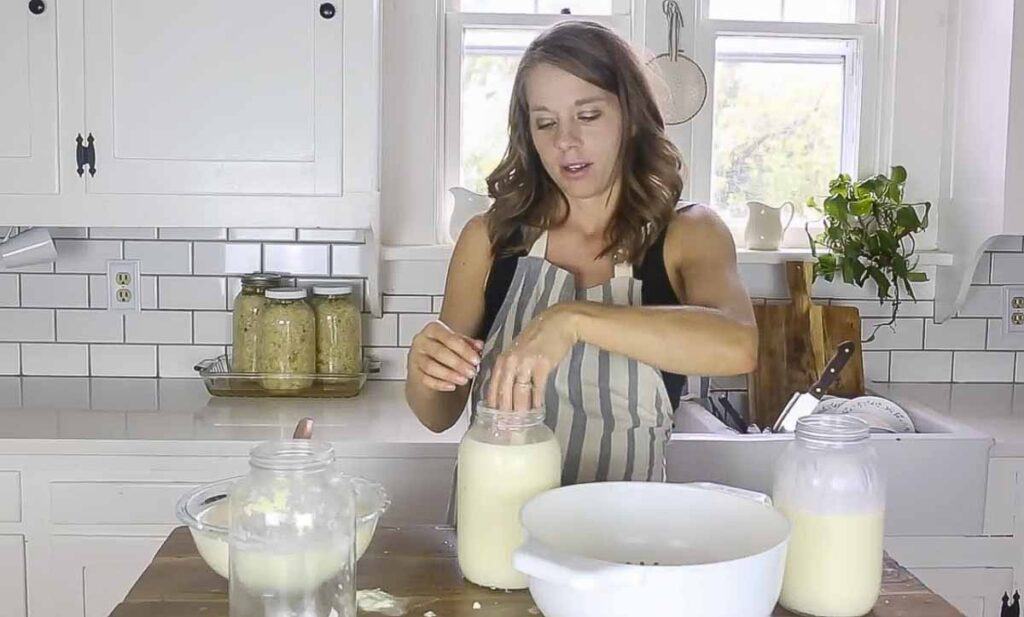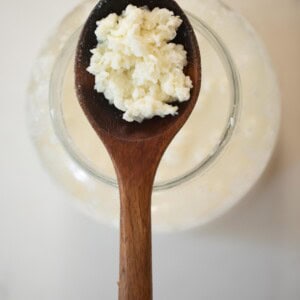Learn how to make Milk kefir. A tangy, creamy, and bubbly fermented milk, rich in gut-healthy probiotics, simple to make, and easily incorporated into our diets.

This post contains affiliate links, which means I make a small commission at no extra cost to you. See my full affiliate link disclosure here.
I love to make fermented foods. I always have something fermenting on the counter, whether homemade sauerkraut, water kefir, kimchi, or even jalapeños. We love it all.
Milk kefir is a fantastic way to begin with fermented foods.
The process is so simple that you can’t mess it up. Unlike yogurt (which is also quite simple), milk kefir requires no specific temperature to culture.
It doesn’t grow mold, as sometimes happens with fermented vegetables when not made correctly.
Kefir is just plain simple, easy to make, and easy to use. It is something that I make every single day in the farmhouse. One of our favorite ways to use it is in a berry kefir smoothie, kefir ranch dressing, or turn it into kefir cheese.
With a constant supply of creamy cow milk from our jersey cow, we are never in short supply. I love knowing that my kids are getting beneficial bacteria on a daily basis.
Benefits of Fermented Foods
Fermented foods came about because of preservation needs — efforts to make foods last longer than they typically would. They were an important part of traditional cultures and have since been shown to contain lots of beneficial bacteria.
According to a PubMed article, the healthy bacteria found in “fermented foods provide many health benefits such as anti-oxidant, anti-microbial, anti-fungal, anti-inflammatory, anti-diabetic and anti-atherosclerotic activity.” (Source)
These days, just about everyone knows how important probiotics are to the body. So many things in our modern lifestyles wreak havoc on the living organisms that inhabit a healthy digestive tract, otherwise known as our gut flora.
It is also widely known that antibiotics like penicillin and amoxicillin destroy healthy gut flora.
But, our modern diet, full of non-organic meats, plenty of processed sugar, and the USDA’s recommended 11 servings of grains per day is also responsible for poor gut health.
Since imbalanced gut flora can contribute to degenerative diseases like cancer and mental health issues, while also hampering the effectiveness of our immune system, it is vitally important to rebuild a damaged gut.
That’s where fermented foods come in. For today’s purposes, specifically milk kefir.
What is Milk Kefir?
Milk kefir is a probiotic-rich fermented drink, beginning with milk that has been soaked with kefir grains at room temperature.
During this soaking, the milk goes through a fermentation process and produces lactic acid and carbon dioxide. The result is a tangy, slightly sour, and bubbly fermented drink.
It’s very similar to a thin, drinkable yogurt. If making your own yogurt interests you, head over to my post on raw milk yogurt in the instant pot. It’s simpler than you’d think and so good!
Why You’ll Love Milk Kefir
Healthy: Milk kefir is probiotic and nutrient-rich. It’s full of protein, calcium, and vitamins B, A, and K, as well as the beneficial bacteria that assist in rebuilding gut health.
Delicious: While it may be an acquired taste, milk kefir does have a pleasant, fresh flavor, much like yogurt. The tanginess and bubbly nature of kefir are quite refreshing.
Great to share with others: Milk kefir is so easy to incorporate in your daily routine. It’s simple to maintain and easy to add to smoothies or overnight oats (and much more!). In an age where everyone is scrambling for the best probiotic gummy vitamins, milk kefir can be exciting to share with friends and family.
Ingredients

Live kefir grains: You can purchase these online or possibly find them locally through a friend willing to share.
Milk: Whole milk works best for milk kefir. I find that raw milk produces the best results.
A full ingredient list with exact amounts can be found in the recipe card below.
Tools You May Need

How To Make Milk Kefir

Step 1: Measure two tablespoons of milk kefir grains into a clean half-gallon jar.

Step 2: Add two cups of milk.

Step 3: Cover with a coffee filter, paper towel, or tea towel, securing with a rubber band. You can also place a plastic lid loosely over the top.

Step 4: Let the milk kefir sit out at room temperature until the desired thickness and sourness are achieved. This will be somewhere between 12-36 hours based on preference. I like the probiotic benefits of extra thick and sour kefir, so I leave mine out for about 36 hours. Others prefer 12 hours.

Step 5: After fermentation, strain the kefir grains out using a strainer. You can use the kefir right away or keep it in the fridge, with a lid, for up to two weeks.

Step 6: You can now start your next batch of milk kefir with those grains, or you can store the grains between batches in the refrigerator in a glass jar covered with milk.
Tips
- When milk kefir grains are “fed” regularly with fresh milk, they will multiply like crazy. Soon you will have more than you even know what to do with! Pass them along to your naturally-minded family and friends.
- The temperature of your kitchen will impact the fermentation time. In the winter, when the temperature is cooler, it may need to ferment longer than during the summer.
- It is normal for the whey to start separating from the milk. This naturally happens with fermentation.
- Kefir grains will last years. I’ve been using the same ones for over six years now.
- You don’t want to add too many kefir grains to your milk or it will ferment much faster than you want.
- When you first start using kefir grains, your milk kefir may not turn out as well as you’d like. This is because they are adjusting to a new environment. Give them a few times to start making really good batches.
- The amount of milk you use will correspond to the amount of kefir grains. If you have a lot of grains, you will be able to use more milk to make more homemade milk kefir.
- Those who have mild lactose intolerance may be able to tolerate kefir, especially if made with raw milk. The fermentation process reduces the amount of lactose present in the milk.
Kefir FAQ
Kefir lasts for up to two weeks in the fridge.
You can use cow, sheep, or goat milk. Raw or pasteurized will work. You can technically use low-fat milk, but it may need to be refreshed with whole milk every once in a while to keep the grains healthy.
I use raw milk and find it to make the highest quality kefir. However, you are still able to make kefir with store-bought milk. The only milk that will not work is ultra-pasteurized (for example, Horizon Organic milk is ultra-pasteurized), so make sure to check your label.
Yes, you can make kefir with non-dairy milk like coconut milk, but you need to alternate back to cow’s milk after a few batches to revive your grains. They will start to lose their effectiveness in plant-based milk alternatives, like coconut and almond. You could also make water kefir.
Drinking kefir any time of day works just fine, but you should avoid drinking kefir in the evening before going to bed. Kefir can affect your digestive system, which may interfere with a good night’s sleep.
Store-bought kefir tends to have less good bacteria than homemade. This is due to the types of cultures used and the commercialized process. Homemade can have around 50 different strains and 20 billion CFUs. (source)
Yes, it’s not only safe but very good for you!
You can safely store kefir grains in the refrigerator for up to 3 weeks. Place the grains in a jar, cover with milk, and add a lid. Place in the fridge.
More Recipes from the Farmhouse
- Fermented Carrots Recipe
- Lacto Fermented Salsa Recipe
- How To Make Sour Cream From Raw Milk
- Homemade Sauerkraut
- Fermented Pickles
If you try this recipe and love it, I would love it if you could come back and give it 5 stars! Tag me on Instagram @farmhouseonboone.
How to Make Milk Kefir

Ingredients
- 2 tablespoons kefir grains
- 2 cups milk, preferably whole
Instructions
- Measure two tablespoons of milk kefir grains into a clean half-gallon jar.
- Add two cups of milk.
- Cover with a coffee filter, paper towel, or tea towel, securing with a rubber band. You can also place a plastic lid loosely over the top.
- Let the milk kefir sit out at room temperature until the desired thickness and sourness are achieved. This will be somewhere between 12-36 hours based on preference. I like the probiotic benefits of extra thick and sour kefir, so I leave mine out for about 36 hours. Others prefer 12 hours.
- After fermentation, strain the kefir grains out using a strainer. You can use the kefir right away or keep it in the fridge, with a lid, for up to two weeks.
- You can now start your next batch of milk kefir with those grains, or you can store the grains between batches in the refrigerator in a glass jar covered with milk.
Notes
-
- When milk kefir grains are “fed” regularly with fresh milk, they will multiply like crazy. Soon you will have more than you even know what to do with! Pass them along to your naturally-minded family and friends.
- The temperature of your kitchen will impact the fermentation time. In the winter, when the temperature is cooler, it may need to ferment longer than during the summer.
- It is normal for the whey to start separating from the milk. This naturally happens with fermentation.
- Kefir grains will last years. I’ve been using the same ones for over six years now.
- You don’t want to add too many kefir grains to your milk or it will ferment much faster than you want.
- When you first start using kefir grains, your milk kefir may not turn out as well as you’d like. This is because they are adjusting to a new environment. Give them a few times to start making really good batches.
- The amount of milk you use will correspond to the amount of kefir grains. If you have a lot of grains, you will be able to use more milk to make more homemade milk kefir.
Nutrition
Nutrition information is automatically calculated, so should only be used as an approximation.











Do you use the strained kefir grains from the first batch over and over?
Yes, I do!
Do you sell your kefir grains? Is the link to the Amazon kefir grains from you?
Hi Lisa!
I just made my first batch and it tastes a little like beer/bread. Is that typical for the first batch or did I just leave it too close to my sourdough starter? If it’s the starter, is that problem? I know you mentioned something about cheese contamination with wheat yeasts being dangerous?
Thanks!
Technically you should ferment them about 3 feet apart, but I keep mine close to each other and have never had that problem. So I’m not totally sure!
Ultra-pasteurized organic whole (or for that matter reduced-fat) milk makes fine kefir. It’s true that Ultra-pasteurization denatures the milk proteins and kills the bacteria, but the kefir grains are concerned with the lactose in the milk. As the kefir cultures, loads of bacteria and yeast strains colonize the milk, and once again the milk is a great probiotic food.
I’ve read that once you get kefir grains, you can use them to make unlimited amounts of kefir. Is this true? And if so, how do you keep them?
Pretty much, as long as they stay healthy you can use them again and again. I’ve been using the same kefir grains for 10+ years. If you aren’t planning to make kefir everyday, the grains can be stored in the refrigerator for up to 3 weeks. Place the grains in a jar, cover with milk, and add a lid. Place in the fridge.
You can actually use ultra pasteurized milk. I’ve been using this and it does just fine. Organic milk by me is always ultra pasteurized unfortunately :/
Same here, lots of brands of organic milk is ultra-pasteurized; however, Trader Joe’s does have simply pasteurized organic milk. Unfortunately, from rankings of organic milk reviews, I’ve read Trader Joe’s brand is not as high quality. The highest quality organic brands, cows that have plenty of room and good foods to eat, are always ultra-pasteurized, and more expensive. Anyway, ultra-pasteurized makes great kefir and the grains stay in great, robust shape long-term. This myth is slowly dying, but still gets repeated, unfortunately.
Hello! Does kefir have a lot of lactose? I am sensitive to lactose..
It depends on how long you let it sit out, but fermentation is very effective in removing lactose.
Does it matter if I just use the original stainless steel lid that the mason jar came with?
I got my kefir grains from your source and made my first batch. But it seemed I had a lot more grains this time. I added them all to my mason jar along with about two cups of milk. It’s separated and looking like it will overflow. Did I add too many grains? How do I use the extra ones? Thank you!
Got my sourdough starter going too! Your recipes for using the part you throw away are a lifesaver!
I had grains given to me but then a very hectic life happened with lots of travel and moves. So my grains have unfortunately been in my freezer for probably over a year now. Is there any way I can bring them back to life? Thanks for any info.